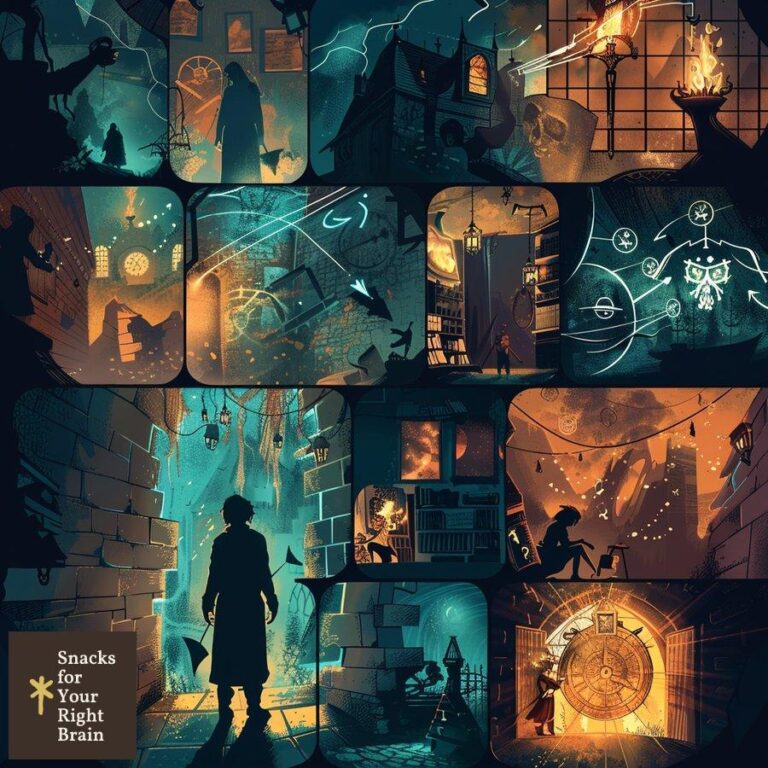What Is Emotional Depth in Writing
What is emotional depth in writing?
Emotional depth in writing refers to the complexity, nuance, and authenticity of the emotions portrayed by characters. It goes beyond surface-level feelings to explore the underlying motivations, conflicts, and psychological states that shape a character’s emotional landscape. Writers who excel at creating emotional depth are able to immerse readers in the characters’ inner worlds, making them feel deeply invested in the story.
Emotional depth is not just about depicting strong emotions; it’s about revealing the intricate web of feelings, thoughts, and experiences that make up the human psyche. Characters with emotional depth are multidimensional, with a range of emotions that evolve throughout the story. They are not one-dimensional stereotypes, but rather complex beings whose actions and decisions are driven by their emotional experiences.
Why is emotional depth important for engaging readers?
Emotional depth is crucial for engaging readers and creating a lasting impact. When readers connect with characters on an emotional level, they become invested in the story and invested in the characters’ journeys. Emotional depth allows readers to empathize with characters, to understand their motivations, and to feel the weight of their decisions.
Moreover, emotional depth adds realism and authenticity to a story. Characters with emotional depth feel like real people, with all the complexities and contradictions that come with being human. This realism helps readers suspend their disbelief and immerse themselves in the story world.
Emotional depth also allows writers to explore universal themes and emotions that resonate with readers on a deep level. By delving into the emotional experiences of their characters, writers can tap into the shared human experience and create stories that feel meaningful and impactful.
How does emotional depth differ from surface-level emotions?
Surface-level emotions are the immediate, outward expressions of feelings that are often easy to identify and describe. They are the emotions that we see on the surface, such as happiness, sadness, anger, or fear. These emotions are important for conveying a character’s state of mind, but they are not enough to create emotional depth.
Emotional depth, on the other hand, goes beyond these surface-level emotions to explore the underlying feelings, thoughts, and experiences that shape a character’s emotional landscape. It reveals the complexity and nuance of a character’s inner world, showing how their emotions are influenced by their past experiences, their relationships, their values, and their goals.
For example, a character might express anger on the surface, but emotional depth would reveal the fear, insecurity, or sense of betrayal that is fueling that anger. Or a character might appear happy, but emotional depth would show the loneliness, doubt, or regret that lurks beneath the surface.
Emotional depth also allows for the exploration of more subtle and complex emotions, such as guilt, shame, jealousy, or ambivalence. These emotions are often harder to identify and express, but they are essential for creating multidimensional characters and exploring the human experience in all its complexity.
What are the key elements of emotional depth?
The key elements of emotional depth in writing are:
-
Complex, nuanced emotions: Characters with emotional depth experience a range of emotions that are not black and white, but rather a mix of feelings that are often contradictory or ambiguous.
-
Authentic, believable reactions: Emotional depth requires characters to react to situations in ways that feel true to their personality, background, and emotional state.
-
Consistent, coherent emotional arcs: Characters with emotional depth undergo emotional journeys that are consistent and coherent, with changes in their emotional state that feel natural and believable.
-
Emotional variety and growth: Characters with emotional depth experience a range of emotions and undergo emotional growth and change over the course of the story.
-
Emotional triggers and motivations: Characters with emotional depth have clear emotional triggers and motivations that drive their actions and decisions.
-
Emotional subtext and unspoken feelings: Characters with emotional depth often have unspoken feelings and emotional subtext that add depth and complexity to their interactions and relationships.
-
Emotional consequences and impact: Characters with emotional depth experience emotional consequences and impact, with their emotions affecting their decisions, relationships, and overall trajectory.
By incorporating these key elements into their writing, authors can create characters with emotional depth that feel authentic, compelling, and relatable to readers.
How can writers create complex, nuanced character emotions?
Creating complex, nuanced character emotions requires writers to delve deep into the psychology and emotional experiences of their characters. Here are some strategies for creating emotional depth:
-
Develop a backstory: Understanding a character’s past experiences, relationships, and emotional wounds is essential for creating complex emotions in the present. Backstory provides context and motivation for a character’s emotional reactions.
-
Explore inner conflicts: Characters with emotional depth often have inner conflicts that create tension and complexity in their emotional lives. These conflicts might be between their desires and their values, their past and present, or their public persona and private self.
-
Reveal thoughts and internal monologue: Allowing readers to see a character’s thought process and inner monologue can reveal the complexity of their emotions and the reasons behind their actions.
-
Use sensory details and body language: Describing a character’s physical reactions, such as facial expressions, gestures, and body language, can convey their emotional state without explicitly stating it.
-
Create emotional variety: Characters with emotional depth experience a range of emotions, not just one or two. Writers should aim to create emotional variety and contrast to add depth and complexity to their characters.
-
Show emotional growth and change: Characters with emotional depth undergo emotional growth and change over the course of the story. Writers should aim to create emotional arcs that feel natural and believable.
-
Use emotional triggers and motivations: Understanding a character’s emotional triggers and motivations can help writers create authentic and compelling emotional reactions. Emotional triggers might be events, people, or situations that evoke strong feelings in a character.
By incorporating these strategies into their writing, authors can create complex, nuanced character emotions that feel authentic and compelling to readers.
What role do inner conflicts and motivations play in emotional depth?
Inner conflicts and motivations play a crucial role in creating emotional depth in writing. Inner conflicts are the internal struggles that characters face, often between their desires, values, and beliefs. These conflicts create tension and complexity in a character’s emotional life, and they drive the character’s actions and decisions.
Motivations, on the other hand, are the reasons behind a character’s actions and behaviors. They are the driving forces that shape a character’s goals, desires, and decisions. Motivations can be conscious or unconscious, and they are often rooted in a character’s past experiences, relationships, and emotional wounds.
When writers create characters with strong inner conflicts and clear motivations, they are able to create emotional depth in several ways:
-
Inner conflicts create emotional complexity: Characters with inner conflicts experience a range of emotions that are often contradictory or ambiguous. This emotional complexity adds depth and nuance to the character’s emotional landscape.
-
Motivations drive emotional reactions: Understanding a character’s motivations can help writers create authentic and compelling emotional reactions. Motivations provide context and justification for a character’s emotional responses to events and situations.
-
Emotional growth stems from inner conflicts: Characters with emotional depth often undergo emotional growth and change as a result of their inner conflicts. As they navigate these conflicts and make decisions, their emotions and perspectives evolve.
-
Emotional subtext emerges from inner conflicts: Inner conflicts can create emotional subtext in a character’s interactions and relationships. The unspoken feelings and tensions that arise from these conflicts add depth and complexity to the story.
-
Emotional consequences stem from motivations: A character’s motivations often lead to emotional consequences, both for themselves and for others. These consequences create emotional impact and add depth to the story.
By creating characters with strong inner conflicts and clear motivations, writers can create emotional depth that feels authentic, compelling, and relatable to readers.
How can subtext and unspoken feelings enhance emotional depth?
Subtext and unspoken feelings are essential for creating emotional depth in writing. Subtext refers to the underlying meaning or implication in a character’s words or actions, while unspoken feelings are the emotions that a character experiences but does not express outwardly.
When writers incorporate subtext and unspoken feelings into their writing, they are able to create emotional depth in several ways:
-
Subtext creates emotional complexity: Subtext adds complexity to a character’s emotional landscape by revealing the gap between what a character says and what they feel. This gap creates tension and depth in the character’s interactions and relationships.
-
Unspoken feelings create emotional authenticity: Characters with emotional depth often have unspoken feelings that they are unable or unwilling to express. These unspoken feelings add authenticity to the character’s emotional experience and make them feel more relatable to readers.
-
Subtext and unspoken feelings create emotional impact: The emotional impact of a scene or interaction is often heightened by the presence of subtext and unspoken feelings. Readers are able to infer the emotional weight of a situation even when it is not explicitly stated.
-
Subtext and unspoken feelings create emotional variety: By incorporating subtext and unspoken feelings into their writing, writers can create emotional variety and contrast. A character might express one emotion outwardly while experiencing a different emotion internally, adding depth and nuance to their emotional landscape.
-
Subtext and unspoken feelings create emotional growth: As characters navigate their relationships and experiences, their unspoken feelings and the subtext in their interactions can evolve. This emotional growth adds depth and complexity to the character’s emotional arc.
To incorporate subtext and unspoken feelings into their writing, writers can use techniques such as:
- Dialogue: Crafting dialogue that reveals the gap between what a character says and what they feel
- Body language: Describing a character’s physical reactions and gestures to convey their unspoken feelings
- Narrative description: Using narrative description to reveal a character’s inner thoughts and unspoken emotions
- Symbolism: Using symbolic elements to represent a character’s unspoken feelings or the emotional subtext of a situation
By incorporating subtext and unspoken feelings into their writing, writers can create emotional depth that feels authentic, compelling, and relatable to readers.
What techniques can writers use to show rather than tell emotions?
Showing rather than telling emotions is a key technique for creating emotional depth in writing. Instead of explicitly stating a character’s emotions, writers can use various techniques to convey those emotions through the character’s actions, thoughts, and sensory details. Here are some effective techniques that writers can use:
-
Body language and facial expressions: Describing a character’s physical reactions, such as facial expressions, gestures, and body language, can convey their emotional state without explicitly stating it. For example, a character might clench their fists or furrow their brow to show anger, or they might fidget nervously to show anxiety.

-
Dialogue and tone of voice: The way a character speaks, including their word choice, tone, and volume, can reveal their emotional state. A character might speak in a hushed whisper to convey fear or in a sarcastic tone to express disdain.
-
Sensory details: Incorporating sensory details, such as sounds, smells, and textures, can evoke emotional responses in readers and create a more immersive experience. For example, a character might hear the sound of their heart pounding in their ears to convey fear, or they might smell the scent of freshly baked cookies to evoke nostalgia.
-
Internal thoughts and reactions: Revealing a character’s internal thoughts, reactions, and decision-making process can provide insight into their emotional state. For example, a character might question their own actions or experience a visceral reaction to a situation, such as feeling their stomach drop or their palms sweat.
-
Narrative description: Using vivid, evocative language in the narrative description can create emotional resonance and convey a character’s emotional state. For example, a writer might describe a character’s eyes as “brimming with tears” to show sadness or a character’s face as “flushed with anger” to convey rage.
-
Symbolism and metaphor: Using symbolic elements or metaphorical language can create emotional depth and convey a character’s emotional state. For example, a writer might use the metaphor of a “heavy heart” to convey sadness or the image of a “dark cloud” to represent a character’s mood.
By incorporating these techniques into their writing, authors can show rather than tell emotions, creating a more immersive and emotionally resonant experience for readers.
How can sensory details and body language convey emotional depth?
Sensory details and body language are powerful tools for conveying emotional depth in writing. By incorporating vivid descriptions of sights, sounds, smells, tastes, and textures, writers can evoke emotional responses in readers and create a more immersive experience. Similarly, by describing a character’s physical reactions, such as facial expressions, gestures, and body language, writers can reveal their emotional state without explicitly stating it.

Here are some ways that sensory details and body language can convey emotional depth:
-
Sensory details can create emotional resonance: Describing the smell of freshly baked cookies can evoke nostalgia, while the sound of a slamming door can create a sense of tension or anger. By incorporating sensory details that are emotionally resonant, writers can create a more vivid and impactful emotional experience for readers.
-
Body language can reveal inner emotions: A character’s physical reactions, such as a clenched fist or a furrowed brow, can convey their emotional state without them needing to verbalize it. By describing a character’s body language, writers can create a more nuanced and authentic portrayal of their emotional experience.
-
Sensory details and body language can create emotional contrast: By juxtaposing a character’s outward appearance with their inner emotional state, writers can create emotional contrast and depth. For example, a character might smile and laugh outwardly while their body language and sensory details reveal their underlying sadness or anxiety.
-
Sensory details and body language can create emotional variety: By incorporating a range of sensory details and body language, writers can create emotional variety and depth in their characters. A character might experience a range of emotions throughout the story, and their physical reactions and sensory experiences can evolve along with their emotional state.
-
Sensory details and body language can create emotional impact: The emotional impact of a scene or interaction can be heightened by the use of vivid sensory details and body language. Readers are able to immerse themselves in the emotional experience of the characters and feel the weight of their emotions.
To incorporate sensory details and body language effectively, writers should aim to use specific, evocative language that creates a clear mental image for readers. They should also consider how a character’s physical reactions and sensory experiences might change based on their emotional state and the context of the situation.
What is the importance of revealing thoughts and internal monologue?
Revealing a character’s thoughts and internal monologue is crucial for creating emotional depth in writing. By allowing readers to see inside a character’s mind and experience their thought processes, writers can provide insight into their emotional state, motivations, and inner conflicts. This technique can create a more intimate and immersive experience for readers, as they are able to connect with the character on a deeper level.
Here are some ways that revealing thoughts and internal monologue can enhance emotional depth:
-
Thoughts and internal monologue reveal emotional complexity: By allowing readers to see a character’s thought process, writers can reveal the complexity and nuance of their emotional landscape. A character might have conflicting thoughts and emotions, or they might question their own feelings and reactions, adding depth and authenticity to their emotional experience.
-
Thoughts and internal monologue create emotional variety: By incorporating a range of thoughts and internal monologue, writers can create emotional variety and contrast in their characters. A character’s thoughts might evolve over the course of the story, reflecting their emotional growth and change.
-
Thoughts and internal monologue create emotional impact: The emotional impact of a scene or interaction can be heightened by the inclusion of a character’s thoughts and internal monologue. Readers are able to see the emotional weight of a situation from the character’s perspective and feel the intensity of their emotions.
-
Thoughts and internal monologue create emotional authenticity: By revealing a character’s thought process, writers can create a more authentic and relatable portrayal of their emotional experience. Readers are able to see the reasons behind a character’s actions and decisions, and to understand their emotional motivations.
-
Thoughts and internal monologue create emotional connection: By allowing readers to see inside a character’s mind, writers can create a more intimate and personal connection between the reader and the character. Readers are able to empathize with the character’s emotional experience and feel invested in their journey.
To incorporate thoughts and internal monologue effectively, writers should aim to use specific, evocative language that captures the character’s emotional state and thought process. They should also consider how a character’s thoughts might change based on their emotional state and the context of the situation.
How can contrasting external actions with inner feelings create depth?
Contrasting a character’s external actions with their inner feelings is a powerful technique for creating emotional depth in writing. By showing a discrepancy between what a character says or does and what they are actually feeling, writers can reveal the complexity and nuance of their emotional landscape. This technique can create tension, irony, and emotional impact, as readers are able to see the gap between a character’s outward persona and their inner emotional reality.
Here are some ways that contrasting external actions with inner feelings can enhance emotional depth:
- Contrasts reveal emotional complexity: By showing a character’s external actions and inner feelings in contrast, writers can## How can contrasting external actions with inner feelings create depth?
Contrasting a character’s external actions with their inner feelings is a powerful technique for creating emotional depth in writing. By showing a discrepancy between what a character says or does and what they are actually feeling, writers can reveal the complexity and nuance of their emotional landscape. This technique can create tension, irony, and emotional impact, as readers are able to see the gap between a character’s outward persona and their inner emotional reality.
Here are some ways that contrasting external actions with inner feelings can enhance emotional depth:
-
Contrasts reveal emotional complexity: By showing a character’s external actions and inner feelings in contrast, writers can illustrate the multifaceted nature of human emotions. For example, a character might smile and laugh at a party while feeling profound sadness inside. This juxtaposition highlights the struggle between societal expectations and personal emotional truth.
-
Contrasts create dramatic tension: When a character’s actions do not align with their inner feelings, it can create dramatic tension and conflict. Readers become invested in the character’s journey as they anticipate when the truth will be revealed. For instance, a character who pretends to be happy in a new job while secretly feeling inadequate can create suspense about their eventual breakdown or confrontation.
-
Contrasts enhance relatability: Many readers can relate to the experience of hiding their true feelings behind a façade. By portraying characters who struggle with this dichotomy, writers can foster empathy and connection. A character who outwardly expresses confidence but internally grapples with self-doubt resonates with readers who have faced similar struggles.
-
Contrasts emphasize character growth: As characters confront the disparity between their external actions and inner feelings, they often undergo significant growth. This journey can lead to self-discovery, acceptance, and emotional resolution. For example, a character who initially hides their true feelings might eventually learn to express vulnerability, showcasing their emotional development.
-
Contrasts enrich thematic exploration: The tension between external actions and inner feelings can serve as a vehicle for exploring broader themes, such as identity, authenticity, and the human condition. Writers can use this contrast to delve into the complexities of societal pressures, personal expectations, and the quest for genuine connection.
To effectively employ this technique, writers should focus on:
- Detailed character introspection: Providing insight into a character’s thoughts and feelings allows readers to understand the emotional conflict at play.
- Vivid descriptions of body language: Contrasting physical expressions with internal emotions can enhance the impact of the discrepancy.
- Symbolic elements: Using symbols or motifs that reflect the character’s inner turmoil can deepen the emotional resonance of the contrast.
What role does backstory play in developing emotional depth?
Backstory is the history of a character’s life that precedes the events of the story. It plays a vital role in developing emotional depth by providing context for a character’s motivations, fears, and emotional responses. A well-crafted backstory enriches a character’s emotional landscape, making their actions and reactions more meaningful and relatable.

Here are several ways that backstory contributes to emotional depth:
-
Contextualizes emotional reactions: Understanding a character’s past experiences allows readers to grasp why they react emotionally in certain situations. For example, a character who experienced abandonment in childhood may struggle with trust in relationships, leading to defensive behavior in the present.
-
Shapes character motivations: A character’s backstory informs their desires and goals, which are often rooted in their past. When readers understand what drives a character, they can better appreciate the emotional stakes involved in their journey. For instance, a character striving for success may be motivated by a desire to prove their worth after facing criticism in their formative years.
-
Explains emotional scars: Characters often carry emotional scars from their past, which influence their present behavior and emotional state. By revealing these scars, writers can create a deeper understanding of a character’s struggles. A character who lost a loved one may exhibit grief and vulnerability that shape their interactions with others.
-
Enhances character complexity: A rich backstory adds layers to a character’s personality, making them more multidimensional. Characters with complex histories are more relatable and engaging, as readers can see how their past shapes their present. For example, a character with a troubled family history may exhibit conflicting emotions, such as loyalty and resentment.
-
Facilitates emotional arcs: Backstory provides a foundation for a character’s emotional growth throughout the story. As characters confront their past and work through unresolved issues, they can experience significant emotional development. This journey can lead to healing, acceptance, and transformation.
To effectively incorporate backstory into emotional depth, writers should consider:
- Strategic revelations: Backstory should be revealed gradually, allowing readers to piece together a character’s history without overwhelming them with information.
- Relevance to the present: The backstory should directly relate to the character’s current emotional state and motivations, ensuring that it enhances the narrative rather than detracting from it.
- Integration with the plot: Backstory should be woven into the main plot, influencing character decisions and relationships in a way that feels organic and cohesive.
How can writers avoid melodrama and overwriting?

Melodrama and overwriting can detract from emotional depth by making characters and situations feel exaggerated or unrealistic. To create authentic emotional experiences, writers must strike a balance between conveying strong emotions and maintaining subtlety and nuance. Here are some strategies for avoiding melodrama and overwriting:
-
Focus on authenticity: Authenticity is key to creating emotional depth. Writers should strive to depict emotions that feel genuine and relatable, rather than exaggerated or forced. This can be achieved by grounding emotional experiences in real-life situations and reactions.
-
Use restraint in language: Overly dramatic language can lead to melodrama. Writers should aim for clarity and precision in their word choices, avoiding clichés and hyperbole. Instead of saying a character “felt like their heart was shattering,” a more subtle approach might be to describe the character’s breath hitching or their eyes welling with tears.
-
Show, don’t tell: Instead of explicitly stating a character’s emotions, writers can convey feelings through actions, body language, and sensory details. This approach allows readers to infer emotions rather than being told what to feel, creating a more immersive experience.
-
Emphasize complexity: Characters with emotional depth often experience a range of conflicting feelings. By portraying this complexity, writers can avoid melodrama and create more relatable characters. For example, a character might feel both love and resentment toward a parent, showcasing the intricacies of familial relationships.
-
Limit exposition: Overwriting can occur when writers provide excessive exposition or backstory that detracts from the emotional impact of a scene. Writers should aim for brevity and focus on essential details that enhance the narrative without overwhelming readers.
-
Incorporate subtext: Subtext allows for the exploration of emotions without overtly stating them. By using dialogue and actions that imply deeper feelings, writers can create emotional depth without falling into melodrama. For instance, a character might avoid eye contact during a conversation, hinting at their discomfort without explicitly stating it.
-
Edit ruthlessly: During the editing process, writers should be willing to cut unnecessary words, phrases, or scenes that do not serve the emotional core of the story. This can help streamline the narrative and enhance emotional impact.
By focusing on authenticity, restraint, and complexity, writers can avoid melodrama and overwriting, creating characters and situations that resonate with readers on a deeper emotional level.
What are effective ways to create emotional variety and growth?
Creating emotional variety and growth is essential for developing characters with emotional depth. Characters who experience a range of emotions and undergo significant growth throughout the story feel more realistic and relatable. Here are some effective ways to achieve this:
-
Establish emotional arcs: An emotional arc outlines a character’s emotional journey throughout the story. Writers should define where the character starts emotionally, the challenges they face, and how they evolve by the end. This arc provides a framework for emotional growth and variety.
-
Introduce conflict: Conflict is a catalyst for emotional growth. By placing characters in challenging situations, writers can explore how they respond emotionally. Internal conflicts, such as grappling with self-doubt or fear, can lead to significant character development.
-
Create diverse emotional experiences: Characters should experience a range of emotions throughout the story. This can include joy, sadness, anger, fear, and everything in between. By showcasing emotional variety, writers can create a more dynamic and engaging narrative.
-
Use relationships as a catalyst for growth: Relationships with other characters can significantly impact emotional development. Writers should explore how characters’ interactions with friends, family, or romantic partners influence their emotions and growth. For example, a character’s friendship may help them confront their insecurities and grow more confident.
-
Incorporate setbacks and failures: Emotional growth is often nonlinear, with characters facing setbacks along the way. Writers can depict moments of failure or disappointment that challenge characters and force them to reevaluate their emotions and motivations. These moments can lead to deeper self-awareness and resilience.
-
Highlight moments of reflection: Characters should have opportunities for introspection and reflection throughout the story. These moments allow characters to process their emotions, learn from their experiences, and make conscious choices about their growth.
-
Show the impact of choices: Characters’ choices should have emotional consequences that contribute to their growth. By depicting how decisions affect a character’s emotional state and relationships, writers can create a sense of progression and development.
-
Balance emotional highs and lows: A well-paced narrative includes both emotional highs and lows. Writers should aim for a rhythm that allows readers to experience the full spectrum of emotions alongside the characters, creating a more immersive experience.
By incorporating these strategies, writers can create emotional variety and growth that enhances the depth and complexity of their characters, making them more relatable and engaging to readers.
How does emotional depth manifest in different genres?
Emotional depth can manifest differently across various genres, as each genre has its own conventions and expectations. However, the core principles of emotional depth—complexity, authenticity, and relatability—remain essential regardless of the genre. Here’s how emotional depth can be expressed in different genres:
-
Literary Fiction: This genre often prioritizes character development and emotional exploration. Writers delve deeply into characters’ inner lives, using rich language and introspective narratives to convey emotional depth. Themes of identity, existentialism, and human connection are commonly explored.
-
Romance: Emotional depth in romance often revolves around the complexities of love and relationships. Writers explore characters’ desires, fears, and vulnerabilities as they navigate romantic connections. Emotional growth is central to the genre, with characters often overcoming personal obstacles to find love.
-
Thriller/Suspense: In thrillers, emotional depth can be conveyed through characters’ psychological states as they face danger and uncertainty. Writers may explore themes of fear, paranoia, and moral ambiguity, revealing how extreme situations affect characters’ emotions and decisions.
-
Fantasy/Sci-Fi: While these genres often focus on world-building and adventure, emotional depth can be integrated through character relationships and personal stakes. Writers can explore themes of belonging, sacrifice, and identity, using fantastical elements to enhance the emotional experience.
-
Horror: Emotional depth in horror often involves exploring fear, trauma, and the human psyche. Writers can delve into characters’ psychological struggles and vulnerabilities, creating a sense of dread that resonates on an emotional level. The exploration of fear can lead to profound emotional experiences for both characters and readers.
-
Young Adult (YA): YA literature frequently focuses on the emotional experiences of adolescence, including themes of identity, friendship, and first love. Writers can explore the complexities of growing up, capturing the intensity of emotions that resonate with young readers.
-
Historical Fiction: Emotional depth in historical fiction often involves exploring the impact of historical events on characters’ lives. Writers can delve into the emotional struggles of individuals living through significant moments in history, creating relatable experiences amidst the backdrop of the past.
Regardless of the genre, writers should strive to create characters with emotional depth that resonate with readers. By understanding the conventions of their chosen genre, writers can effectively incorporate emotional complexity and authenticity into their narratives.
What are effective exercises for developing emotional depth in writing?
Developing emotional depth in writing requires practice and intentionality. Here are some effective exercises that writers can use to enhance their ability to create emotionally rich characters and narratives:
-
Character Journaling: Write journal entries from the perspective of a character, exploring their thoughts, feelings, and experiences in depth. This exercise helps writers understand a character’s emotional landscape and motivations.
-
Emotion Mapping: Create a visual map of a character’s emotional journey throughout the story. Identify key emotional moments, conflicts, and growth points, helping writers visualize the character’s emotional arc.
-
Dialogue Practice: Write a scene where characters express conflicting emotions through dialogue. Focus on subtext and body language to convey deeper feelings without explicitly stating them.
-
Flashback Writing: Write a scene that reveals a character’s backstory through a flashback. Explore how past experiences shape their current emotions and behaviors, adding depth to their character.
-
Sensory Detail Exercise: Choose a specific emotion and write a scene that conveys that emotion through sensory details. Focus on how sights, sounds, smells, and textures can evoke feelings in both characters and readers.
-
Inner Monologue Exploration: Write a scene that includes a character’s internal monologue during a pivotal moment. This exercise helps writers explore the complexities of a character’s thoughts and emotions.
-
Contrast Writing: Write two scenes that contrast a character’s external actions with their inner feelings. This exercise highlights the emotional depth that arises from discrepancies between what characters show and what they feel.
-
Emotional Conflict Scenarios: Create scenarios where characters face emotional conflicts, such as choosing between loyalty and honesty. Write scenes that explore their emotional struggles and the consequences of their decisions.
-
Character Interviews: Conduct fictional interviews with characters, asking them about their feelings, fears, and desires. This exercise encourages writers to delve deeper into their characters’ emotional lives.
-
Feedback and Reflection: Share writing with peers or writing groups and seek feedback on emotional depth. Reflect on how readers perceive the emotional experiences of characters and make adjustments accordingly.
By engaging in these exercises, writers can develop their skills in creating emotional depth, leading to more authentic and relatable characters and narratives.
How can writers edit their work to enhance emotional depth?
Editing is a crucial phase in the writing process, allowing writers to refine their work and enhance emotional depth. Here are some effective strategies for editing to improve emotional resonance:
-
Focus on character consistency: Ensure that characters’ emotions and actions are consistent throughout the narrative. Review character arcs to confirm that emotional growth feels authentic and coherent.
-
Trim unnecessary exposition: Remove excessive backstory or exposition that detracts from the emotional impact of a scene. Focus on essential details that enhance understanding without overwhelming readers.
-
Enhance sensory details: Review descriptions to ensure they evoke the intended emotions. Incorporate sensory details that create a vivid emotional experience for readers, allowing them to immerse themselves in the character’s feelings.
-
Evaluate dialogue for subtext: Analyze dialogue for opportunities to convey deeper emotions through subtext. Ensure that characters’ words align with their inner feelings, creating tension and complexity.
-
Check for emotional variety: Assess whether characters experience a range of emotions throughout the story. Ensure that emotional highs and lows are balanced and contribute to character development.
-
Refine internal monologue: Review internal monologue for clarity and depth. Ensure that characters’ thoughts effectively convey their emotional struggles and growth.
-
Seek feedback on emotional impact: Share work with beta readers or writing groups to gather feedback on emotional depth. Ask readers to identify moments that resonate emotionally and those that feel flat.
-
Revise for clarity and precision: Edit language to ensure clarity and precision, avoiding melodrama or overwriting. Aim for authenticity in emotional expression, using specific language that captures the nuances of feelings.
-
Consider pacing: Evaluate the pacing of emotional moments in the narrative. Ensure that emotional beats are given enough space to resonate with readers without feeling rushed.
-
Reflect on overall emotional arc: Review the overall emotional arc of the story, ensuring that it aligns with character development and thematic exploration. Make adjustments as needed to enhance emotional depth.
By applying these editing strategies, writers can refine their work to create emotionally resonant narratives that engage readers and leave a lasting impact.






